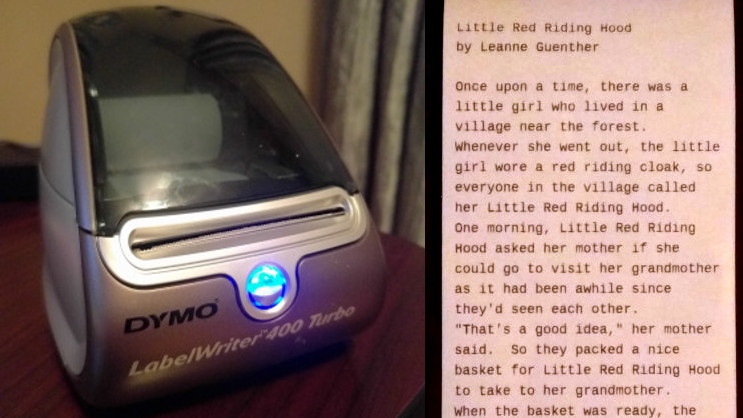We know how it happens. You buy a fancy new label printer, thinking this is the answer to your disorganized space, but soon entropy grabs the printer as well, and it becomes just another item in the pile. When you find such items later, though, they can spark ideas. The idea that struck [Eric Nichols] was to turn his diminutive thermal printer into a dedicated one for short stories.
Inspired by an article about a vending machine that dispenses stories selected by the reader’s time constraints, [Eric] took on the task of getting his Dymo LabelWriter 400 Turbo working in this new capacity. The first task was finding some continuous roll paper that would fit, because the official stock for this thing is all labels. He got lucky on the first try and a roll of 2 7/16″ receipt paper fit the bill perfectly.
The printer itself doesn’t have much brains; it prints bitmaps 672 bits wide, and as long as you care to make them. While the initial experiments succeeded in printing graphics, [Eric] needed a way to convert his stories to bitmapped text to send to the printer. The human-readable font file format known as BDF (glyph Bitmap Distribution Format) was a perfect fit, since a library to render it was readily available. On top of that, the open-source tool otf2bdf will convert a TrueType (TTF) font to BDF, completing his font-rendering chain.
[Eric] has these printers working with both Linux and windows, either one running on a PC where his software resides, and has it all well-documented on his site. With this in place, it’s simply a matter of coming up with the stories to print. We think it would be perfect for Hackaday dailies!
We’ve seen interesting hacks with disused printers before, like this ascii-art generating cartridge.















Wow, I didn’t know tools like otf2bdf were already openly available, it will really help anyone who wants to have bitmap fonts in embedded projects. BDF looks really simple and powerful at the same time.
All modern printers, laser or inkjet, print on cut sheets of paper. One of the things I miss about line printers and fanfold paper is the ability to have the printer log errors, debug info and progress on long jobs. However I don’t miss it enough to justify keeping a dot matrix printer for such occasional uses. But I have one of these sitting on my desk, and I ‘m now thinking I could use it as a debug printer. The ‘little stories’ angle is of no use to me, but it has sparked an idea that will be very useful.
Thanks guys
I remember some inkjets that did tractor feed and sheet feed. Probably Canon BJ series.
I’ve got a very old BJ10 that can print either way, but no centronics interface and no drivers on a modern desktop m/c. Imma try dymo + python + bdf = progress!
Take a look next time you’re inside it, might still have a 20 pin header on the motherboard for parallel port.
I keep all kinds of junk here, need to plug a parallel printer into an android tablet, no problem, gimme a sec..
When I got a refurbished i7 in 2016, I chose in part to make sure it had PS/2, serial and parallel ports. Maybe if I couldn’t get an i7 with those I’d drop them, but since they were available, I wanted them.
I’ve never used the serial or parallel ports. My HP printer died just as I was going to hook it to the new computer. No use for serial, but I used a dial up modem to 2012 and have a few things around.
No floppy disk drives, and I don’t remember seeing an internal connector for them. I do have drives, even 5.25 inch.
Maybe when I splurge on a top of the line new computer when I hit 65 in five years, I’ll give up serial and parallel
I’m getting strong deja vu on this, maybe I’m remembering the thing that inspired Eric.
Does it print out “Ladle rhett rotten hut”?
If you have a choice, don’t try this with a Brother QL-series label printer. They’re functionally similar to the Dymo, just a thermal friction-feed printer.
However Brother uses printed stripes on the back side of the label to determine label type and alignment. So if you come across one of these models, you’ll have to hack it somehow to fool it into using a continuous roll. Which may be fun.
But the thermal paper is kind of expensive. Back when dot matrix printers were still the normal. I had successfully printed source code on toilet paper. It is a very cheap source of paper. In fact, the cheaper ones are the the better ones. You can reuse it too, once.
The good thing is that is you’re producing shit code, at least it’ll not take time to debug.